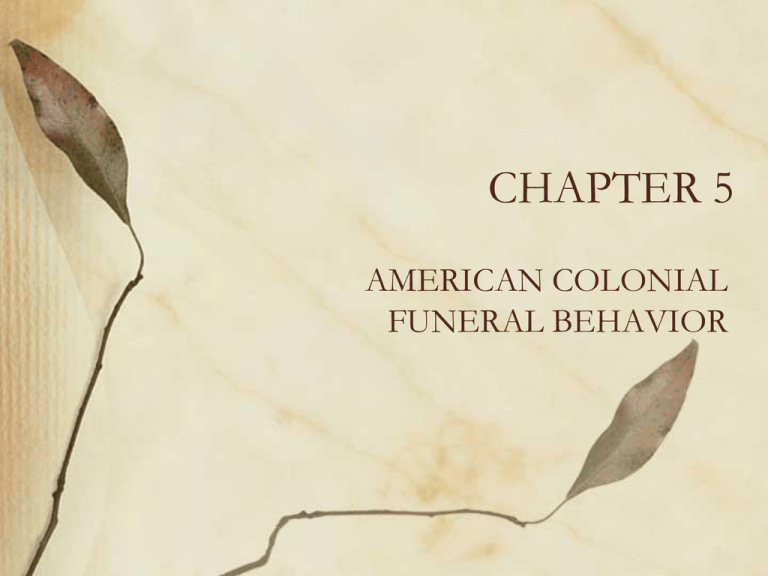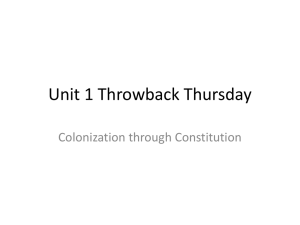CHAPTER 5 - Introduction To Mortuary Sciences
advertisement

CHAPTER 5 AMERICAN COLONIAL FUNERAL BEHAVIOR American Colonial Funeral Behavior • American settlements were founded by people seeking fortune and freedom from religious organization or a chance to acquire a decent human existence. • People brought to America a body of beliefs and institutions, skills, arts and crafts. Ideological framework for Colonial Funeral Practices: • Virginia Colony– Integrated church and state until after the Revolution. – Death became one of the prime occasions for pulpit exhortations on the essential mortality of mankind and moral living. – Puritans “disinvolved” the clergy from certain ceremonial functions including funerals. Ideological framework for Colonial Funeral Practices: • Virginia Colony– New England burials were very simple and done with quiet dignity. It was their goal to avoid the “popish” (pertaining to the Pope or Roman Catholic Church) errors of saying prayers over the dead. • Nevertheless funerals were preached in churches starting in 1700’s • Later prayers were said at the graveside ceremonies. Ideological framework for Colonial Funeral Practices: • Virginia Colony– Colonists shed their legal system of church (ecclesiastical) law and formalized the New World Society by Common Law– “If it isn’t a reasonable law, it can’t be a good law. – England remained the same as before until English Burial Acts of 1855 then reflected more of the colonists ways. Ideological framework for Colonial Funeral Practices: • Virginia Colony– Many common law precedents were set during this time, because not all of the existing laws fit the exigencies (case or situation that demands prompt attention) of colonial existence. – Most of this came about because there was no clear-cut definitions for mortuary behavior… • No Church Involvement Remember…. Ideological framework for Colonial Funeral Practices: • Virginia Colony– Early colonists believed that work, ownership, substance and salvation all became parts of unity of existence that made up life in the colonies, founded upon the principal that hard work was kin to Godliness. Ideological framework for Colonial Funeral Practices: – Industriousness was necessary but not completely sufficient for salvation…The state of ones soul was, in the end, and individual matter… • Were you righteous or not?? – The ministry was preaching Hell-fire and damnation sermons that scared many of the colonists, therefore they were forced into a realm of philosophical speculation and an in depth examination of other ideas. Ideological framework for Colonial Funeral Practices: – This speculation led to the pursuit of mans worldly goods as an end in themselves. Common laws, industriousness, and an uncertain, fearful relation to God formed the major elements of the Puritan character. – It is against these values that figures of funeral practice and death customs started to form from their own interests. Funeral Directing in the 19th Century • Early New England recognized death as natural, common place reality… • “The grave was as common as the cradle and the New Englander never saw any reason to disguise it.” • Cemeteries were familiar to living and the dead alike as “resting places for the dead” Funeral Directing in the 19th Century • Funeral directing became an occupation during the 19th century by: – providing a set of tasks for the care and disposal of the dead. – taking the form of a personal service. Framework for Colonial Funeral Practices • Virginia Colony- founded in 1607 at Jamestown. It had a commercial motif (format). They had no quarrel with the Church of England. • Massachusetts Bay Colony- It had a religious motif. It was underwritten by people called “undertakers”. Mass. Bay Cont. • The pilgrims of Mass. Bay rejected all known religions and started their own theology (Puritian). • They rejected the use of clergy from ceremonial customs. Early Puritan Laws and Practices • No clergy participated in funerals or weddings because it was considered a civil matter. • Therefore, the body was to be interred without benefit of ceremony or prayer. • Burial services consisted of: – procession to the grave and – placement in and filling of the grave. (Pg. 123) Early Puritan Laws... • Because the funerals were so simple the tombstones were the only way to show respect, and they were often very elaborate. • They were laden with literary expressions: – They may have been ridiculous, pompous, eloquent or serenely simple. Early Puritan Laws... • Yet the fact remained that the dead were not alienated from the living…. Death was never denied!!!!! • Deaths were common place because of Indian raids, accidents, killings, hangings and natural death, but sickness was the most feared. Early Puritan Laws... • Small Pox epidemics occurred again and again. • It was not uncommon to loose children in infancy and spouses by 2 or 3 times. • Remarriages were the order of the day. General Practices of Colonial Funerals • Hearse- a hand carried bier with candles or spikes on the corners. • Had little resemblance to the modern vehicle in which the casket is transported in. • Broadside sheet- a hand bill of sorts, which contained the eulogy, the most popular included skull and crossbones. • Colonial press found fruitful in their labors in the printing of broadside sheets General Practices of Colonial Funerals • Crudely and gruesomely decorated with macabre symbols of death; skulls crossbones scythes, coffins, hourglasses, all-seeing eyes, skeletons, and winding sheets. General Practices of Colonial Funerals • Funeral sermons of leading men were often printed, as were exemplary confessions made by criminals prior to their execution. • Mourning took on an extensive social character. General Practices of Colonial Funerals • Gifts were given to those attending the funerals they included: rings, scarves, gloves, purses, tobacco, liquor, books. – This was brought from New England and the feudal funeral. – “In the case of prominent State or Church or Society vast numbers of gloves were given away. – The gloves varied in quality depending on your relationship to the dead. General Practices of Colonial Funerals • Governor Belcher’s wife in 1736: – Over 1,000 gloves were given away. You should know what is coming, right? • Laws permitting extraordinary expenses at funerals (sumptuary laws). General Practices of Colonial Funerals • Some spent over 1/5 of their estate on these gifts……. – The funeral of Andrew Fanevil in 1738• 3000 gloves were given out and over 1,100 people accompanied the funeral cortege to the grave. General Practices... • In 1651 the General Assembly of the Province of Massachusetts passed Sumptuary (Excessive) Legislation against funeral costs. This was because the funeral could leave the widow poor because the estate was often used up on the funeral. The Funeral Process • Basic Funeral in New England in the 18th century: – A neighbor or nurse usually laid out the body, however; it was unusual to have a formal viewing. – The coffin was built usually by a local cabinetmaker and was elaborately carved. • Wood was a quality that fit the social position of the deceased. • Sometimes “coffin furniture” was added (metal decorations). The Funeral Process Cont. – Relatives within a few days travel were notified. • It was not customary to allow the body to lie in state. • In warm weather the body was disemboweled and wrapped in cerecloth. (sheets soaked in alum, pitch or wax) Funeral Process Cont. • Gifts were distributed to all who attended. (gifts of rings, scarves or gloves) • Services began in the church with prayers and a sermon. A pall was used. • Ministers began using funerals for their “fire and brimstone” sermons. Funeral Process Cont. • The sermons were often printed on the broadside sheet. Procession to the Grave • Was usually done on foot. – Minister – Honoraries – Underbearers were used if a hearse was not available. – Pallbearers (men of dignity) carried the pall. – At the grave prayers were said. – The grave was filled by all who were present. Gravediggers • Sometimes if no gravediggers were present neighbors provided the service. • Usually the sexton would dig the grave and tolled the bell to announce the death. • Prayers were said at the graveside. • The grave was filled with all present. Widows Duties • We now see the first instance of friend and relatives traveling distances for the funeral service. • The widow had the duty of feeding and housing all of the guests. • Entire neighborhoods usually attended. • Entertainment was expected. Widows Duties • Food and liquor was expected and consumed in large quantities. • The costs of liquor usually exceed the cost of the food and casket combined. • • • • • • • By a pint of liquor for those who dived for him……1s By a quart of liquor for those who brot him home…2s By two quarts of wine and one gallon of cyder to jury of inquest…………………………………....5s By 8 gallons of 3 quarts wine for funeral……….L1-15s By barrel cyder for funeral…………………………16s 1 coffin…………………………………………….12s Windeing sheet……………………………………..18s Widows Duties • The funeral of Calie Dawes (1797) – At the funeral feast they served: • Rum, wine beer, gin and brandy … • Dinner featured beef, ham, bacon and fowls, for funeral baked meats, supplemented by fish and oysters, 150 eggs, peas, onions, potatoes, followed by cheese, fruit and sweetmeats…. • The total cost: $844.00 In 1797 $844.00 roughly was equal to $8000 to $10,000 today Widow Cont. • Tobacco was given to the men in large amounts. • The funeral always included the children (sometimes as pallbearers) in order to teach them about death. – It was hoped that the “little ones” might be impressed with the significance of death as an inevitable end of a life of trial an probation Dutch Colony Funeral Customs • Funerals took place 3 or 4 days after death. • Intensive and important ceremony. • The best parlor was used. • They used a pall covering the coffin and the bier. • Taken to the graveyard (churchyard) by 12 pallbearers. Dutch Colony Funeral Customs • After the interment they went back to the house where food, tobacco and drink were distributed. • Aansprecker- a licensed official who attended to funerals. Dutch Colony Funeral Customs • Monkey-Spoon- an image of a saint on the handle of a spoon. They looked more like monkeys then humans. The spoons were given to the pallbearers as a gift. Revolutions which changed funeral customs • 1775- War of Independence • Commercial relations between England became strained by embargo acts, so there was a reduction in trade between the colonists and the homeland. • The colonists started to limit themselves to the morning paraphernalia they had on hand. Embargo Acts Cont. • The Economic Wars, mainly the embargo acts, occurred before and especially after the War. – Use of clothing items as gifts decreased. – Bands of crepe (black arm bands) replaced the customary new suit for the funeral. – Ribbons on bonnets and dresses replaced new dresses. – Gloves were given only to the bearers. – 8 shillings each was all the undertaker and sexton could charge of each service. Funerals before the Revolutionary War • An extremely religious service in the colonies. • Funeral festivities were always social events and apart from the actual service. • No class distinction, all funerals were fairly equal. • Ostentation was high with gift giving. Funerals After the Revolutionary War • Still religious, but became more secular. • Class distinction was made on the basis of worldly possession rather than family lineage. • There were no social barriers, as far as social climbing was concerned. • The number of plumes (feathers) on a hearse displayed a persons status. Funerals After the Revolutionary War • Colonial Funerals generally combined three functions: • Sociability • Religiosity • Reaffirmation of established social status of deceased. American Undertakers • The authors of the book looked for the earliest appearance of the “American Undertaker” but information was very limited. • In a 1786 directory of New York, most people were listed by occupation.. • Interestingly enough a sexton was listed but no undertakers. American Undertakers • The role of the American Undertaker actually began to emerge in the 19th century.











